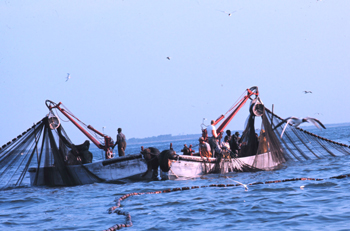Herring and Menhaden Pressuring Lobstermen
by Fishermen’s Voice Staff

Small scale harvesting of menhaden, Chesapeake Bay 1970's. Consolidation of the fish reduction industry has left one company, the Omega Company of Reedsville, VA, in the business of producing fish oils and fish meal for fertilizer and pet food. The total menhaden quota in 2008 was 187.000 metric tons. In 2002 it was over 400,000 metric tons. NOAA Photo
Maine lobstermen “are blessed with a very healthy resource,” said Maine Lobstermen’s Association Executive Director Patrice McCarron. At the same time McCarron noted one of the most difficult issues facing lobstermen is the cost of doing business. Landings are high at a time when lobster prices are low. Among other costs the price of fuel is up and bait prices have been rising steadily.
The price of bait has risen regardless of how the harvest numbers for bait fish vary. The herring quota in the inshore area (1A) of the Gulf of Maine was 60,000 metric tons (MT). That has been cut back to 24,000 MT.
In the offshore area 3A it remains at 38,000 MT. “But sometimes the boats can’t find the herring in either area. The herring may be in there, but they may not be aggregating, schooling up where they can be fished,” said McCarron. The resulting shortage can drive up prices. However, catches can suddenly be abundant, but the prices continue their steady rise.
As the herring quota was cut back demand for menhaden, or pogies, has grown. In 2006 menhaden made up about 6 percent of the lobster bait in Maine. By 2008 it was 19 percent according to the Maine DMR port sampling figures. McCarron said the increased use of pogies for bait has been fairly steady. The 2010 figures were not available but based on the 2006 to 2008 increase the backup bait role for pogies could be as high as 32 percent now. (Maine has been doing port sampling since 1966. DMR representatives collect the data by interviewing captains at the dock.)
As more fishermen fish more to the cover their costs to catch low priced lobster, they are expected to need more bait. This comes at a time when the Atlantic States Marine Fisheries Commission (ASMFC) at a meeting in Boston on November 11 moved to cut the menhaden harvest by what Toni Kerns of the ASMFC described as a significant amount.
Kerns didn’t have a mathematically derived figure to quote, but in response to a number of inquires said a rough estimate of a 37 percent cut is expected. She said that is not an official number. But she did say it is not likely to be dramatically different.
According to the ACMFC draft document, “The Maximum Spawning Productivity (MSP) approach identifies the fishing mortality rate necessary to maintain a minimum level of stock reproductive potential relative to the potential maximum stock productivity under unfished conditions. A 15 percent MSP would equate to a fishing mortality rate threshold required to maintain approximately 15 percent of the spawning potential of an unfished stock.
An unfished stock is equal to 100 percent MSP. Given the current level of fishing mortality equates to a MSP of approximately 8 percent. The new reference points are intended to provide increased protection for spawning adults, which given optimal environmental conditions, may result in increased juvenile abundance. This approach is consistent with the recommendations of the 2009 stock assessment peer review panel.”
About 80 percent of the menhaden harvest goes to the reduction industry which presses the oil out of the fish and and sells the rest as fertilizer, pet food, etc. The remaining 20 percent goes to various uses, which include recreational fishing and lobster bait.
The reduction industry, centered in Chesapeake Bay, harvested 187,000 metric tons in 2008 and 214,000 metric tons in 2007. The highly consolidated industry has one remaining reduction plant. That company, Omega Industries in Reedville, Virginia owns its own fleet of trawlers and processing plant. Menhaden is harvested from the Carolinas to Maine.
It is the older 6- and 7-year-old spawning menhaden that historically have traveled to the Gulf of Maine. However, very few menhaden have been seen in Maine waters for about 15 years. Most are harvested in Virginia or off New Jersey.
Proponents of the cuts to fishing on spawn said the cuts will soon result in a larger amount of menhaden being available for bait. Zack Klyver of Bar Harbor said allowing this keystone species, which is forage for cod to whales, to be strengthened is good for everyone including the lobstermen who are relying on it more now just as they had in the past.
